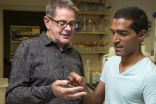The results provide some of the most dramatic evidence to date of the potential of therapies that increase the ability of the immune system to kill cancer cells. While clinical trials of such immunotherapies in other cancers have shown them to be highly effective in a subgroup of patients, the new study stands out because nearly all patients benefited from the treatment.
The success of the agent, nivolumab, in this study has prompted the U.S. Food and Drug Administration to designate it a "breakthrough therapy" for treating relapsed HL, and a large, multinational Phase 2 trial is now under way.
"What makes these results especially encouraging is that they were achieved in patients who had exhausted other treatment options," said the study's co-senior author, Margaret Shipp, MD, chief, Division of Hematologic Neoplasia at Dana-Farber. "We're also excited by the duration of responses to the drug: the majority of patients who had a response are still doing well more than a year after their treatment."
The study involved 23 patients with relapsed or treatment-resistant HL, a cancer of white blood cells called lymphocytes. Although relatively uncommon - with less than 10,000 new cases each year in the U.S. - it is one of the most frequent cancers in children and young adults. While the disease can often be treated successfully with current therapies, up to a quarter of all patients eventually have a relapse.
In the current study, almost 80 percent of the patients had undergone a previous stem cell transplant. More than a third had received at least six prior lines of therapy without lasting success.
The patients received biweekly infusions of nivolumab, which is an antibody that blocks a protein called PD-1 on the surface of immune system T cells. T cells are key actors in the body's defenses, identifying foreign or diseased cells and leading an assault on them. But when PD-1 binds to proteins called PD-L1 and PD-L2 on the surface of certain cancer cells, the T cells essentially become paralyzed: the immune attack on cancer is called off. By blocking PD-1, nivolumab allows the attack to proceed.
"This is a treatment that, rather than targeting cancer cells themselves, targets the immune response, reactivating the T cells in the neighborhood of the tumor cells," Shipp remarked.
Twenty of the 23 patients had a measurable response to the treatment, with four achieving a complete response - in which no detectable tumor was left - and 16 having a partial response - in which their tumors shrank to less than half their original size. Six months after completing therapy, 86 percent of the patients were alive with continued responses. Most patients continue to do well a year after their treatment.
Side effects mirrored those that have occurred in tests of nivolumab in patients with solid tumors. About 20 percent experienced a serious treatment-related adverse effect but none was life-threatening.
The approach to immunotherapy embodied in nivolumab is a legacy of work at Dana-Farber that began in the 1980s. Dana-Farber's Gordon Freeman, PhD, and his wife, Arlene Sharpe, MD, PhD, of Harvard Medical School, did some of the original research that resulted in the identification of PD-1 on T cells, as well as the PD-L1 and -L2 protein "ligands" on tumor cells. "Their work was critical to our understanding that the increased presence of PD-L1 and -L2 on some tumor cells may allow those cells to escape attack from the immune system," Shipp said.
Freeman and Sharpe's work dovetailed with Shipp and her colleague's own research into the genetic features of HL. "We found that Hodgkin lymphoma tumor cells frequently have an extra region of a specific chromosome that causes an increased production of the two ligands - PD-L1 and PD-L2 - in the PD pathway," Shipp said. "This characteristic genetic alteration suggested that inhibiting the PD-1 pathway might be particularly effective in this disease." In collaboration with local colleagues Scott Rodig, MD, PhD, Azra Ligon, PhD, and Bjoern Chapuy, MD, PhD, the group found that tumors from all analyzed trial patients had the genetic alteration.
Shipp and her co-authors offer two possible explanations for the high response rate to nivolumab in this study. One has to do with the sparse nature of HL. "Hodgkin lymphoma is unusual among cancers in that it consists of a small number of tumor cells in a sea of inflammatory cells and immune system cells, including T cells that don't work very effectively." Shipp observes. "Activating those T cells may create a very strong response to a relatively small number of cancer cells." Another related possibility is the genetic trait that causes HL cells to produce an abundance of PD-L1 and PD-L2 ligands makes the tumor particularly vulnerable to PD-1 blockade.
For the investigators involved in the research, the results, though obtained in a relatively small, phase 1 trial, are compelling. "For someone like myself, in this kind of work, this is the kind of result that you get to see once in your career," said study co-senior author Philippe Armand, MD, PhD, medical oncologist in the Hematologic Oncology Treatment Center at Dana-Farber.
INFORMATION:
The study was supported by Bristol Myers Squibb, National Institutes of Health grants R01CA161026, U54CA163125, and P01AI056299 and with support from the Miller Family Fund to the Shipp laboratory.
Co-first authors of the study are Stephen Ansell, MD, PhD, of the Mayo Clinic and Alexander Lesokhin, MD, of Memorial Sloan-Kettering Cancer Center. Additional authors are Ivan Borrello, MD, of Johns Hopkins University School of Medicine and the Sidney Kimmel Comprehensive Cancer Center; Ahmad Halwani, MD, of University of Utah Huntsman Cancer Institute; Emma Scott, MD, of Oregon Health and Science University; Martin Gutierrez, MD, of Hackensack University Medical Center; Stephen Schuster, MD, of Abramson Cancer Center, University of Pennsylvania; Michael Millenson, of Fox Chase Cancer Center; Deepika Cattry, MS, of Memorial Sloan-Kettering Cancer Center; Gordon Freeman, PhD, and Bjoern Chapuy, MD, PhD, of Dana-Farber; Scott Rodig, MD, PhD, and Azra Ligon, PhD, of Brigham and Women's Hospital; Lili Zhu, MS, Joseph Grosso, PhD, Su Young Kim, MD, PhD, of Bristol-Myers Squibb; and John Timmerman, MD, of Jonsson Comprehensive Cancer Center, University of California, Los Angeles.
About Dana-Farber Cancer Institute
Dana-Farber Cancer Institute, a principal teaching affiliate of Harvard Medical School, is world renowned for its leadership in adult and pediatric cancer treatment and research. Designated as a comprehensive cancer center by the National Cancer Institute (NCI), it is one of the largest recipients among independent hospitals of NCI and National Institutes of Health grant funding. For more information, go to http://www.dana-farber.org.



